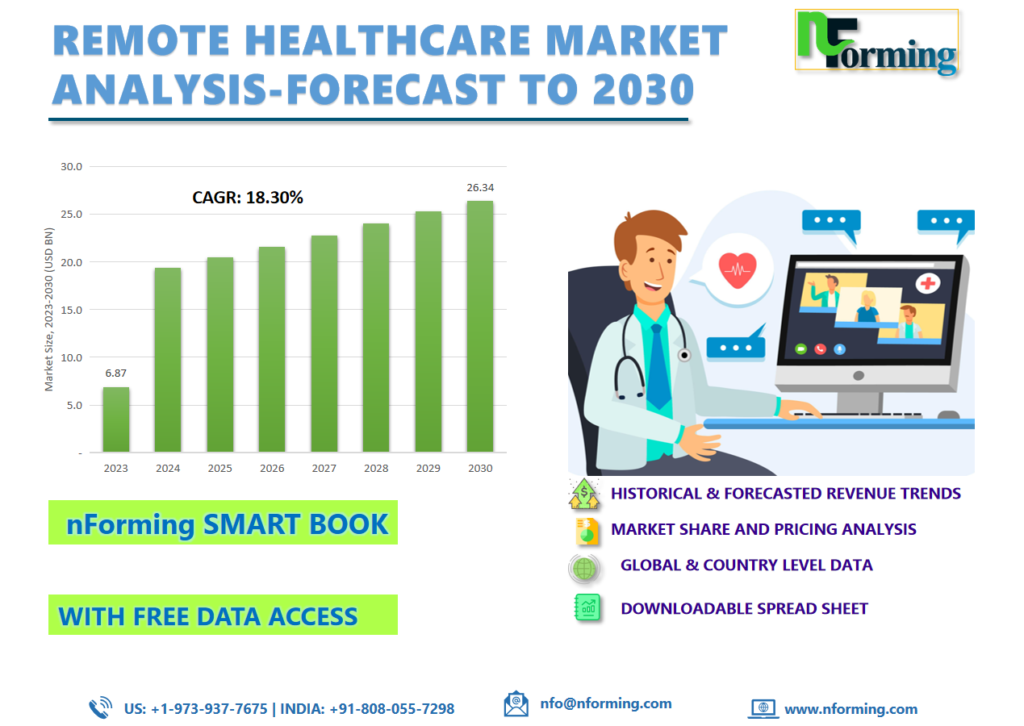
Remote Healthcare Market Definition
Industry Perspective:
The global Remote Healthcare Market was worth USD 6.87 billion in 2022 and is estimated to grow to USD 26.34 billion by 2030, with a compound annual growth rate (CAGR) of approximately 18.30% over the forecast period. The report analyzes the Remote Healthcare market’s drivers, restraints/challenges, and their effect on the demands during the projection period. In addition, the report explores emerging opportunities in the Remote Healthcare market.
Remote Healthcare Market: Overview
Remote healthcare is the delivery of health treatments and information using electronic and telecommunications technology. This allows healthcare personnel to diagnose, discuss, treat, and monitor patients without the requirement for physical presence, expanding medical aid to sites that are geographically far or otherwise difficult to reach. It also includes various services such as telemedicine consultations via video chats, remote patient monitoring via wearable devices, and digital platforms that provide medical advice or prescriptions. It is a complete approach to healthcare that uses technology to bridge the gap between patients and medical professionals, making healthcare more accessible, cost-effective, and efficient.
nForming Remote Healthcare Market Smart Book
The nForming Remote Healthcare Market Smart Books offer a comprehensive compilation of data pertaining to historical revenue, user volume, patient data, prices, and other relevant information for each segment. This includes, products & services, type of indication, age group and detailed analysis of service providers with coverage at both regional and country levels. The data spans the past three years and provides projections up until 2030. The smart book also provides extensive information on the leading suppliers and their corresponding market shares in the Remote Healthcare Market. The Remote Healthcare Market comprises a range of qualitative factors, including significant growth drivers, opportunities, and challenges.
Remote Healthcare Market Recent Developments
The Remote Healthcare industry is seeing a variety of developments. Among the major developments areas are;
Recent Developments
- In February 2021, BioTelemetry, Inc., a major provider of remote cardiac diagnostics and monitoring, was bought by Koninklijke Philips N.V. The goal of this strategic acquisition was to improve the company’s patient care management products. This technique aided the organization in improving its service offerings and driving revenue development.
- In December 2021, GlobalMed announced the addition of more virtual care delivery service offerings to its CostSimplified program, which allows organizations to adopt and provide access to users of virtual health stations, devices, and software platforms for a low monthly fee. This plan will increase patient access while also increasing income for the corporation.
Read more opportunities of Remote Healthcare market in the Smart Book.
Remote Healthcare Market Drivers
Increased frequency of chronic diseases to promote remote healthcare to drive market growth
Chronic illnesses such as diabetes, hypertension, and heart disease necessitate ongoing monitoring and long-term treatment, making remote healthcare services especially beneficial in these cases. Remote patient monitoring systems can capture vital signs, glucose levels, and other important variables, allowing healthcare providers to intervene in real time. This continuous data stream aids in illness management and may avert complications, resulting in fewer hospitalizations and associated healthcare expenses. Furthermore, telemedicine consultations provide the convenience of routine check-ups from the comfort of one’s own home, which is especially useful for patients with mobility issues or those living in rural places. In essence, the development in chronic diseases increases the demand for flexible, efficient, and ongoing healthcare, all of which remote healthcare services naturally deliver.
Remote Healthcare Market: Restraints
Concerns about security and privacy hinders market growth.
A significant barrier to the expansion of the remote healthcare industry is Concerns about security and privacy. Concerns about security and privacy are important impediments to the widespread use of remote healthcare. Patients are concerned about the privacy and security of their personal health information (PHI), as well as the possibility of data breaches. They are also concerned about the confidentiality of their medical communications and the possibility of unauthorized access to their health information. Furthermore, there are several security and privacy hazards involved with remote healthcare. Data breaches, malware assaults, unauthorized access, and a lack of encryption are among the hazards.
Read all major drivers and trends of Remote Healthcare market in the Smart Book.
Remote Healthcare Market Regional Landscape
North America dominated the Remote Healthcare market in 2022
This is due to the region’s strong awareness and use of remote healthcare technologies. According to a 2019 survey done in the United States by American Well, 66% of consumers were willing to adopt telehealth, including real-time virtual health. Furthermore, 64 million consumers in the United States were willing to switch their primary care physician to video visits/consultations in 2019, up from 50 million in 2017. 65% of customers had used a health monitoring device, according to the same survey. Furthermore, the presence of a significant number of remote healthcare technology providers, as well as sophisticated healthcare infrastructure, contributes to market growth.
Read more competitive developments in the Remote Healthcare Market Smart Book.
Remote Healthcare Market Key Companies
Advanced ICU Care
BioTelemetry
Koninklijke Philips
Teladoc Health
Vivify Health
AirStrip Technologies
Medtronic
InTouch Technologies
American Well
Resideo Life Care Solutions.
Remote Healthcare Market Segmentation:
The global Remote Healthcare market has been segmented into service, end-user, and mode of transit.
Based on service, remote patient monitoring, real time virtual health (Video Communication, Audio Communication, and Email/Chat box), and tele-ICU are segments of the global remote healthcare market. The tele-ICU segment dominated the market in 2022. The segment is being propelled by the initiatives, partnerships, and collaborations of major stakeholders. For instance, an eICU programme was introduced by Philips Healthcare and Showa University in Japan in May 2020. This project aimed to advance the globalisation of critical care while simultaneously improving outcomes for high-risk patients.
Based on application, the market is classified into diagnosis, cardiology, obstetrics, senior care, and others. In 2022, the diagnosis category dominated the global market. The use of telehealth technology for diagnosing medical disorders is the main emphasis of diagnosis. It entails video call consultations, image sharing for dermatological or radiological analyses, and other remote diagnostic procedures. Growth in this area is essential for the overall development of the remote healthcare market since it frequently serves as the starting point for additional medical treatment.
Based on end-users, the market is classified into payer, provider, patient, employer groups, and government organizations. In 2022, the provider category dominated the global market. This is due to hospitals’ increased adoption rates of remote healthcare technologies to lessen the mounting strain on healthcare systems. The demand for remote patient monitoring and real-time virtual health services is being driven by a dearth of doctors, nurses, and hospital beds, particularly in developing nations. To relieve the strain on hospital staff, many hospitals are also building tele-ICU units. For the deployment of tele-ICU in June 2020, AdventHealth Ottawa, a provider of tele-ICU based in the U.S., worked together. The segment is being driven by these partnerships.
Segmentation:
Remote Healthcare Market, By Service |
|
Remote Healthcare Market, by Application |
|
Remote Healthcare Market, by End-User |
|
Remote Healthcare Market, By Geography |
|
Frequently Asked Questions (FAQs):
- Which key factors will influence remote healthcare market growth over 2023-2030?
The main reasons anticipated to propel the remote healthcare market during the forecast period are the growing use of smartphones, mHealth apps, wearable technology, and digital healthcare is expected to fuel the global distant healthcare industry. Furthermore, the growing amount of investment in the remote healthcare industry
- What will be the value of the remote healthcare market during 2022-2030?
According to the report, the global Remote Healthcare market size was worth USD 6.87 billion in 2022 and is estimated to grow to USD 26.34 billion by 2030, with a compound annual growth rate (CAGR) of approximately 18.30% over the forecast period.
- Which region will contribute notably towards the remote healthcare market value?
North America is anticipated to continue leading the remote healthcare market throughout the projected period.
- Which are the major players leveraging the Remote Healthcare market growth?
Some of the main competitors dominating the global Remote Healthcare market include – Advanced ICU Care; BioTelemetry; Koninklijke Philips; Teladoc Health; Vivify Health; AirStrip Technologies; Medtronic; InTouch Technologies; American Well; Resideo Life Care Solutions.
-
GET FREE DATA ACCESS!

